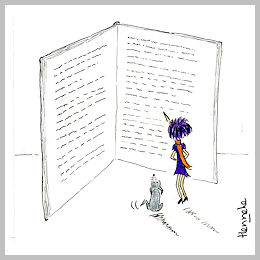 Yeah, yeah.
Yeah, yeah.
We know that stories engage.
We know that stories entertain.
But including stories in our blog posts seems a difficult task.
Storytelling has definitely vexed me for a long time.
How do you avoid sounding like a girl who keeps blabbing on about her life story, her travels, her boyfriend? How do you avoid boring everyone to tears with uninteresting details?
You’re either a born storyteller or you can’t tell stories. Right?
Wrong.
Storytelling can be learned.
I’m not talking about writing novels. Including tiny or miniature stories in your blog posts is much easier. And once you know the tricks, your blog posts become more personal. You make your readers smile. And keep them reading on.
Sound good?
Use tiny stories in tutorials
Do you write how-to posts?
And do you use examples in your tutorials?
You can easily turn your examples into interesting stories.
Let’s say you’re writing a blog post about email marketing. You’d like to point out that when you send a sales pitch in your email you need to explain what’s in it for the customer.
You could give a simple example about a web developer offering a special deal on blog set-ups in his email. You recommend that the web developer describes the offer, and tells his email readers how their business can benefit from a blog, such as more search engine traffic, an opportunity to start a conversation and build a relationship with prospects, etc.
With a little effort you could turn this example into a short story:
Imagine you’re a web developer.
You have a good client base, but most of your customers have static websites only. No one seems to blog.
You don’t have many leads in the pipeline, so you want to sell a few blog packages to your existing clients. After all, it’s easier to sell something to existing clients than to look for new prospects, isn’t it?
You write your next e-newsletter about blogging. You highlight the number of blogs in the world. You show a few examples of popular business blogs.
You keep it short as nobody has time to read these days. You add a call-to-action with a 20% discount for blog packages purchased before the end of the month.
You push send and wait for the phone to ring.
You check your stats, and sure, your email gets opened, but why is no one interested? Why is the phone not ringing?
You presented the facts about blogging, but you forgot to connect it to your client’s business. How can a blog help them grow their business?
Have you noticed how little I told you about the web developer in the example above? And how in just two sentences I describe the idea of selling a few blog packages?
A tiny story sets the scene quickly.
After describing the context in a couple of sentences, a tiny story becomes active. It explains what the protagonist does rather than what he thinks.
To add drama, you give the reader the feeling that something will go wrong. The question After all, it’s easier to sell something to existing clients than to look for new prospects, isn’t it? makes you wonder whether this web developer is overconfident about selling to existing clients. Is it more difficult than he thinks? As a reader, you’re waiting for a problem to arise.
The most common mistake when including stories in your blog posts is to make them too long. Remember to focus on your key message only, and ask yourself for each detail: Is this relevant? Can I delete it?
Write a first draft, and aim to reduce your story length by 50% when you’re editing.
Use tiny personal stories as metaphors
You’re not just blogging to tell stories are you?
You want to build your authority, develop relationships with readers, and win clients. You want people to get to know you, like you, and trust you.
Tiny personal stories help readers to learn more about you. Here’s an example from a post about welcoming first time readers on your blog:
The village seemed deserted.
The only shop was closed.
It was Thursday afternoon, half past four. Exhausted from cycling in the heat, we were longing for a shower, a snack, and a cold beer.
We knocked on the door of the village hotel.
Nobody answered.
The door was locked.
Was the hotel closed?
We tried the back door and found it was open. We sneaked in and discovered a key and a piece of paper with Mrs Henneke – room 10 written on it.
We showered and hand washed our clothes; and then waited for somebody to turn up. We had nothing to eat, just tap water to drink, and the wifi wasn’t working.
Not a welcome you’d like give your visitors, huh?
But that’s exactly what happens on your website, my website, and everyone else’s website. We are not around to personally greet each web visitor and guide them in the right direction.
As a blogger, you might like to build a relationship with your readers. But your readers aren’t coming to read about you. Readers come to be inspired, entertained, or educated.
The trick with personal stories is to make the story about your reader rather than about you. Here’s an example outline:
- Don’t start with your story, but pull your reader into your blog post by empathizing with his struggles and promising a solution.
- After you’ve pulled your reader into your blog post, tell him your story; keep it short.
- Include your tips, tricks, or formulas in the main body of the post.
- Inspire your reader with your closing paragraph; get him to take action.
How to write your own tiny stories
Don’t feel you need to become the next Gabriel Garcia Marquez, Haruki Murakami, or Elizabeth Gilbert.
Tiny stories aren’t hard to tell.
A story is simply a journey.
Let your readers witness your journey, live your story. Transfer them away from their desk and cellphones.
Decide on your message. Imagine talking to your ideal reader. And captivate her with your words.
Recommended reading on storytelling:
How to delight blog readers with mini-stories
How to inspire people with your business mission
How to share personal stories (even if you feel shy)


What I really like about your posts is that you not only tell WHAT to do but that you give examples and demonstrate HOW to do it.
There are so many blog articles, slideshares ect. with a promising title and all you find inside is: be human, be authentic be this and that but they DON’T actually SHOW how being human, authentic etc. could look like.
Really good job and thanks for sharing your knowledge.
Thank you, Matthias. Glad you’re finding my posts useful!
I agree with you – a lot of blog posts promise a lot, but deliver very little. So many posts are superficial – quickly thrown together, regurgitated content.
I appreciate you’re taking the time to leave a comment 🙂
Love the village hotel story. The visual it creates is powerful!
Thank you, Melinda. It’s a true story!
Hi Henneke
This post came in at the right time. I have been cautiously approaching the idea of writing a bribe, have done all my research but then I started dragging my heels when it came to doing some writing. Thats because I wanted a fresh angle. Your idea of story telling is brilliant. Thank you!!!
Yep, stories, fresh examples, and metaphors can give any topic a fresh angle.
Thank you, Nokthula. Glad you found it useful!
I love your stories, Henneke! We are always curious about different people, different cultures, and different routines from our own. Keep on tellin’ your cyclin’ stories. And thanks for the reminders to us to do the same. 😉
Thank you, Penelope. I’m glad I’m not boring you to tears yet 😉
When we’re having an actual conversation with someone else, I think we naturally tell short stories. But it’s more of a challenge to add them into the flow of a blog post. So thank you for illustrating so succinctly how to do this 🙂
Yep, you make a good point. In conversations, we always tell stories, and then we know how to keep our audience captivated. Good to “see” you here, Sarah 🙂
We DO come around to hear your stories…but only if they are thin disguises for “what’s in it for me!” How right you are, Henneke!
Surprisingly, Marion Roach Smith is in agreement with us. She is the author of The Memoir Project.
Memoir, many are thinking, IS about the person in question. Not according to Smith. Successful memoir is about connecting the Universal [what’s in it for them] with the Particular [that specific incident].
She applies it to feature writing. But as I’m rereading her book, I’m noting how much of it also applies to copywriting.
Always a pleasure to dive a bit deeper with you every Tuesday.
Sounds like an interesting book! I think that whenever we write something to publish – whether it’s a blog post, a memoir, a novel, or a business book – we should write for our ideal reader.
Thank you for stopping by again, Lori.
Henneke:
Thanks for taking the theory and providing tangible steps to put it to work — even when it is not our natural tendency. This is one of the many reasons I have become an avid reader…you do more than reinforce emerging concepts but make them accessible. Thank you!
You’re welcome, Dara. Glad you found it useful. Thank you for all your tweets and for stopping by 🙂
Hi Henneke; I’m learning so much from you which reminds me to read your book – Blog to Win Business, I just bought ASAP. 🙂
I hope you’ll enjoy the book and find it useful, Joy. Let me know?
I really enjoy your style and I recently built a story around getting prospective home buyers prepared to purchase a new home . My metaphor was from my many years of racing motocross/supercross to mortgage banker and my goal is to educate them in gettng prepared. I really like your example with your web developer, excellent and thank you.
Sounds like an interesting metaphor. I love metaphoric posts 🙂
Thank you for stopping by, Marc!
I just love your blog and it makes sense to me, a mere beginner in the business and blogging world.
I always seem to get it right with my ‘facebook’ posts as the posts which get the most reach and comments are my ramblings at the end of the day…. the ‘ what a day I’ve had post’ but I can’t seem to get it right where my blog is concerned. Perhaps I think of business too much when I write them.
Your writing always inspires me to try harder though… You write how I like to read.
Facebook posts are perhaps a little easier to freewrite (without editing) as they’re relatively short?
I spend quite a lot of time editing my posts (although I’m getting quicker) to make them easy to read and conversational.
Thank you for stopping by, Karina 🙂
Henneke – thanks very much for giving us some practical pointers on which to do this.
I know that telling a story is key, but if you’re not a story teller then it’s tricky to do – LOL
I’d forgotten about using analogies in the written form…
Off to practice in the garden in sunny North Wales!
Hey Caroline, it’s sunny here up north, too 🙂
I bet you’re good at telling stories with visuals!
You know, I think you are absolutely right. I’ve often wondered at the most popular of all my posts, how they actually are ones that are not exactly on the topic of my site, or even the overall theme of my readers’ lives. I used to think it was just fun to read about something different, but now?
I realize they are almost all posts that tell a story. What a fun discovery! I must make a new page directing readers to all the stories!
And you can tell about cycling adventures without boring. I love your stories. They’re not really about cycling, so much, anyway. Today’s was really about a hotel experience, something universal enough to make a great point. And you made it just a bit eerie, so I was wondering what was lurking somewhere in the building, or if some mass exodus had occurred just before you arrived. And I’ve read that one before, here, somewhere, but it was worth the second read. 🙂
I like you’re idea of a mass exodus not just from the hotel, but from the whole village. Just because two sweaty Dutch cyclists are arriving 😉
nice… a story is simply a journey. What a beautiful way to make storytelling simple. And thank you for providing some examples to clarify your points. Very helpful post Henneke!
Good to see you again, Daphne. Thank you for stopping by! 🙂
Henneke, you are not boring us and you’re not blabbing on. I love your updates (and your drawings!).
You are right about storytelling — it’s so much more powerful than a regular post. Reminds me of the topics discussed in “Made to Stick” by Chip and Dan Heath. Readers love mysteries, and humans always want to bridge their knowledge gaps, even with trivial matter. The news is on fire this week with Kim and Kanye’s wedding because people want to know — talk about trivial! Anyway, great book. Highly recommend to anyone trying to understand what motivates people and what doesn’t.
Thanks, as always.
You make an excellent point about mysteries and knowledge gaps.
“Made to Stick” is one of my favorite non-fiction books. Have you read their book “Switch”? That’s really good, too. “Decisive” is on my list to read, but I’ve heard it’s not as good as the other two.
Good to see you again, Melissa. How’s your blogging going?
PS I do often blab on when I write my first draft 😉
Henneke – storytelling is a great way to connect ideas to your reader. The web developer example shows a typical problem of not connecting the story. Adding stories to topics is an easier way to make the topic your own, vs just another post about XYZ.
Cheers!
Yep, that’s so true. Tiny stories are a great way to differentiate your blog posts from other blah-blah how-to list.
Thank you for stopping by, Darren 🙂
Henneke,
This was a useful tip. I’ve been trying to include small stories in my articles, but you’ve given me some new angles.
BTW, your own story is more interesting than you think it is.
Glad you found it helpful 🙂
I’m always dead-frightened that I’m boring people with my cycling stories!
You followed this exact outline in your blogpost. Well done, a teacher who heeds her own advice! 😉
Ha yes, I do my best 🙂
You are a better student of yourself than I am :-/
Perhaps you’re too strict as your own teacher? Or just too rebellious as student?
Always the latter!
Not only great advice, but vivid example that kept me riveted. If that mini-story does not help me “get it” nothing will. After all the reader is accountable too.
There’s good readership in all of us, especially when we encounter writers who demo they care by their clarity and finish. When I am hooked, I am not counting words or minutes. I am loving what’s been offered.
Such is the case of this morning’s post. sQs 7:14am Florida time.
Good morning, Stephen. Thank you for stopping by so early. Glad to see you’re still around! 🙂
Great advice. so much easier to tell a story and entertain. I will have to find a way to incorporate that into what I blog about. Thanks
It’s easier than it seems!
Thank you for stopping by, Venessa.